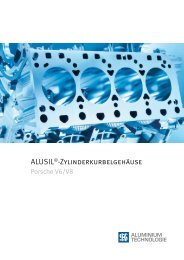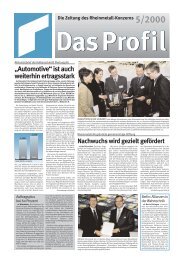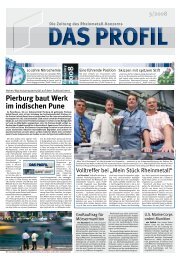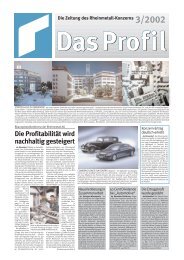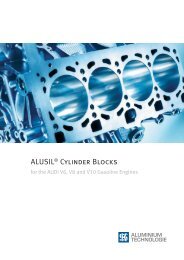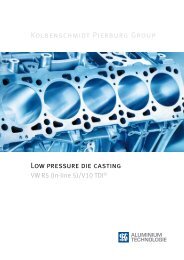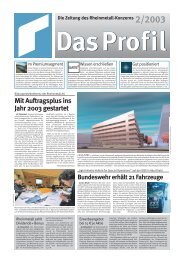Annual Report 2001 - KSPG AG
Annual Report 2001 - KSPG AG
Annual Report 2001 - KSPG AG
Create successful ePaper yourself
Turn your PDF publications into a flip-book with our unique Google optimized e-Paper software.
28<br />
Management report on the Kolbenschmidt Pierburg Group<br />
Executive Board report<br />
The core competence of Aluminum<br />
Technology is the casting of engine<br />
blocks from aluminum according to<br />
various processes. Due to the ongoing<br />
substitution of gray cast iron by lightweight<br />
aluminum, the market is still<br />
growing. Given the continuously rising<br />
technical requirements and falling<br />
market prices, close and cooperative<br />
OEM teamwork and simultaneous<br />
engineering have proven themselves.<br />
The division’s development activities<br />
focus on process refinements, further<br />
and new developments of cylinder<br />
sleeve concepts, material developments<br />
including technologies for local<br />
material reinforcement and added<br />
downstream machining (vertical integration).<br />
The strategy of sharpening<br />
our profile over rivals through wideranging<br />
concepts and specific problem<br />
solutions over competitors is making<br />
good progress.<br />
Maintaining high quality standards<br />
while keeping manufacturing costs<br />
down calls for constant and reproducible<br />
processes. The division’s process<br />
development covers the entire production<br />
chain from the casting to the<br />
ready-to-ship product. Computer-aided<br />
simulation tools for mold filling and<br />
solidification are used in the development<br />
of new products right from the<br />
start. In fact, computer-aided process<br />
planning comprises the entire valueadding<br />
chain. Conventional engineering<br />
techniques are constantly being<br />
fine-tuned, too. The automatic monitoring<br />
and controlling of the casting<br />
process have become an integral<br />
element of production technology.<br />
New technical solutions concentrating<br />
on the central and critical element of<br />
the engine block, the cylinder sleeve,<br />
will continue to be the force driving<br />
new product concepts. The fact that the<br />
division has all the standard solutions,<br />
especially for gasoline engines, as<br />
well as concepts of its own, will enable<br />
it to stand out in the marketplace.<br />
Within this context, a megaproject for<br />
a new aluminum engine block to go<br />
into a strong-selling V6 engine was<br />
awarded by a German carmaker.<br />
The commencement of new projects,<br />
mainly in the low-pressure casting<br />
sector, was a focal point of product<br />
and process development. In recent<br />
years, more and more high-performance<br />
passenger car diesel engines<br />
have been using an aluminum engine<br />
block. In two ambitious projects, including<br />
a ten-cylinder V-engine, the<br />
preproduction phase was successfully<br />
completed. In <strong>2001</strong>, innovative<br />
ideas for engineering the cylinder<br />
sleeve were again explored.<br />
This division’s R&D expenses amounted<br />
to €5.0 million in the past fiscal<br />
year, 3.7 percent of sales.<br />
In fiscal <strong>2001</strong>, R&D activities by Motor-<br />
Engineering focused on the core areas<br />
of exhaust gas measuring units, flowmeters,<br />
and measuring equipment for<br />
workshops.<br />
In the measurement of exhaust gases,<br />
product generation 4000 made further<br />
advances. The same applies to the<br />
CVS 4000 exhaust gas dilution system,<br />
the particle collector, and the minidiluter.<br />
A new automated CHD 4000<br />
dynamometer saw development startup.<br />
These efforts continued against<br />
the background of employing only the<br />
latest technologies to achieve the<br />
prescribed cost reduction targets.<br />
The expected series production of gasoline<br />
engine high-pressure injection<br />
systems (GDI) in Europe and the USA<br />
was shelved beyond the year <strong>2001</strong><br />
and hence resulted in a postponement<br />
for Pierburg Instruments Inc. in the USA<br />
in the use of precision flowmeters for<br />
high-pressure applications. In 2002,<br />
the product range is being rounded<br />
off with a system metering the intake<br />
air of I.C. engines in order to meet<br />
customer demands for single-source<br />
measuring units.<br />
The measuring equipment for workshops<br />
unit pushed ahead with a PCaided<br />
version of the diesel opacimeter<br />
for measuring diesel exhaust gases.<br />
Work continued on an intelligent<br />
interface for communicating with<br />
automotive control units. The basis<br />
for this are the expected EOBD regulations<br />
(European On-Board Diagnosis)<br />
as well as the alternative exhaust gas<br />
inspection methods of a well-known<br />
German carmaker. Work on a new<br />
monochrome graphics adapter for<br />
gas testers was also completed, as<br />
was the origination of software for<br />
bidirectional data communication<br />
between gas tester and computer.<br />
MotorEngineering spent €3.2 million<br />
on R&D activities, equivalent to 8.4<br />
percent of sales.<br />
Final inspection at the<br />
solenoid assembly line<br />
at the Neuss plant


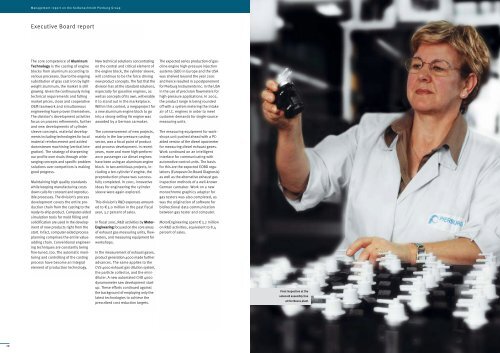
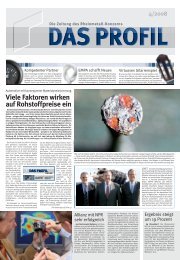
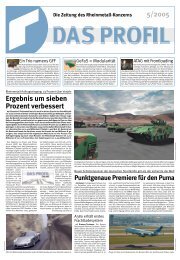
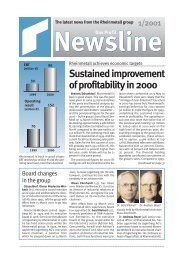
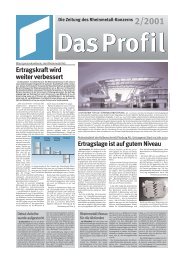
![PDF [1.0 MB] - KSPG AG](https://img.yumpu.com/5513074/1/171x260/pdf-10-mb-kspg-ag.jpg?quality=85)
